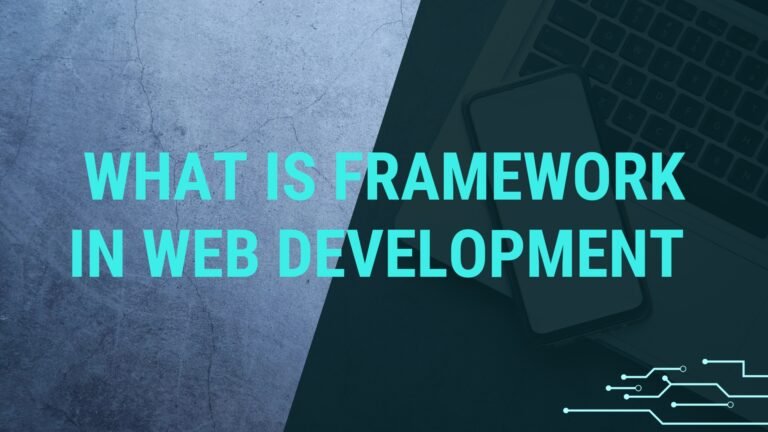
What is a framework in web development?
The process of developing a website is intricate and requires some different tools and technologies. The use of frameworks is an essential component of web development. A framework in web development is software that gives programmers a framework and a collection of tools to help them create web applications quickly and effectively. Providing pre-existing code and libraries streamlines the development process and frees engineers to concentrate on creating certain functionalities rather than beginning from scratch.
What is a web framework in web development?
A framework in web development is a set of pre-written code and libraries that are the basis for developing web applications. It provides developers with tools, features, and pre-built structures to help them create web applications quickly and effectively.
How does a framework in web development operate?
To facilitate standard web development tasks like routing, database administration, and user authentication, a web framework offers a collection of libraries and tools. The many parts of an application are divided using a specific architecture, such as the Model-View-Controller (MVC) pattern. This division of responsibilities enhances code organization and maintainability.
What advantages come with using a web framework?
The use of web frameworks provides developers with some advantages:
- By offering a framework and a collection of tools, it streamlines the development process by lowering the quantity of code created from scratch. The development team will save time and effort as a result.
- Security features and best practises are frequently included in frameworks, which enhances the general security of web applications.
- They offer a standardised method for creating web apps, facilitating developer collaboration and single-source project management.
Types of Framework in Web Development
Server-side architectures
Web frameworks that operate on the server and produce dynamic web pages are known as server-side frameworks. They take care of an application’s processing and business logic. Ruby on Rails (Ruby), Laravel (PHP), and Django (Python) are a few examples of server-side frameworks.
Client-side models
As the name implies, client-side frameworks operate on the client side, usually within the user’s web browser. They concentrate on an application’s user interface and user experience. A few well-liked client-side frameworks are Vue.js, Angular, and React. These frameworks enhance the functionality and performance of web applications.
Client-side models
As the name implies, client-side frameworks operate on the client side, usually within the user’s web browser. They concentrate on an application’s user interface and user experience. A few well-liked client-side frameworks are Vue.js, Angular, and React. These frameworks enhance the functionality and performance of web applications.
A web application framework: what is it? An explanation of a framework for web applications
A particular kind of framework made especially for creating online apps is called a web application framework, or simply a web app framework. It offers a more systematic approach to application development and a higher level of abstraction by encapsulating standard web development features.
What distinguishes a web framework from a web application framework?
All frameworks associated with web development, including web application frameworks, are collectively referred to as web frameworks. A web application framework, on the other hand, specialises in web application development and offers extra capabilities and resources for creating intricate online apps.
Popular frameworks for web applications
These days, some well-liked web application frameworks are accessible. ASP.NET, Laravel, Django, and Ruby on Rails are a few of the more popular ones. These frameworks are renowned for their broad community support, scalability, and resilience.
What is a framework for web development? An explanation of a framework for web development
A web development framework comprises an all-inclusive collection of tools, libraries, and techniques that facilitate the creation of web applications. It covers client-side and server-side programming and gives programmers an organised method for creating online applications.
What role does a web development framework play in building web apps?
A web development framework offers pre-defined structures and easily customizable functionalities that give developers a base to build on. It reduces repetitious work, expedites the development process, and aids in preserving consistency throughout the application. Furthermore, to facilitate a smooth development process, web development frameworks frequently interact with other programmes and services, including databases and online APIs.
Web development framework examples:
For many programming languages, there are multiple web development frameworks available. Several well-known instances are Flask (Python), Express.js (JavaScript), Ruby on Rails (Ruby), and Django (Python). The thorough documentation, user-friendliness, and versatility of these frameworks are well known.
Describe Django? An Overview of Django
Python is used to create the high-level web application framework Django. It emphasises clean design, code reuse, and quick development while adhering to the MVC architectural pattern. Django has an extensive feature set and toolset that make it easier to create sophisticated web applications.
Aspects of Django
Numerous features are available with Django, such as an integrated administration interface, a robust template engine, an ORM (Object-Relational mapping) for database management, and user authentication. Moreover, it offers thorough documentation and a vibrant community, facilitating developers’ onboarding and help-seeking processes.
Benefits of Web Development with Django
The use of Django for web development has many benefits. First of all, Django adheres to the DRY (Don’t Repeat Yourself) concept, which enables programmers to create code that is reusable and free of redundancies. Along with prioritising security, it has built-in defences against typical online risks. In addition, Django is a flexible framework for a wide range of online applications, thanks to its vast ecosystem and third-party libraries.
JavaScript frameworks: what are they? An explanation of frameworks in JavaScript
Frameworks for JavaScript offer an organised method for creating JavaScript applications. They provide pre-writte_n code and frameworks to make typical tasks like managing events, DOM manipulation, and AJAX queries easier. JavaScript frameworks make it simple for developers to create dynamic and interactive web apps.
Popular Frameworks for JavaScript
There are several JavaScript frameworks out there, and each has benefits and features of its own. The most well-known JavaScript frameworks are Vue.js, Angular, and React. These frameworks’ performance, scalability, and broad community support make them popular for frontend developers.
Benefits of JavaScript Framework Usage
For web developers, using a JavaScript framework has various advantages. First, frameworks offer an organised method for developing applications, enhancing the maintainability and organisation of the code. To save time and effort during development, they also provide libraries and ready-made UI components. JavaScript frameworks, with features like virtual DOM and effective data binding, also contribute to better web application performance and user experience.

FAQ's
What is a framework in web development?
A framework is a pre-established structure that provides a foundation for building software applications. It includes reusable code, tools, and conventions to streamline development tasks.
How does a framework differ from a library?
While both frameworks and libraries offer pre-written code, a framework dictates the overall structure and flow of an application, while a library provides specific functionalities that developers can use as needed.
What purpose does a framework serve in web development?
In web development, a framework simplifies the building process by offering a set of tools and guidelines. It promotes consistency, scalability, and efficiency in designing and maintaining web applications.
Why use a framework in web development?
Utilizing a framework enhances productivity by reducing the need to write repetitive code. It enforces best practices, aids in collaboration among developers, and often comes with built-in features for common tasks.
Conclusion:
In conclusion, understanding the concept of a framework in software development reveals its pivotal role in providing structure, efficiency, and consistency. Whether applied to the broader software development landscape or specifically in web development, frameworks serve as invaluable tools for developers. They streamline the coding process, encourage best practices, and foster collaboration. As evidenced by frontend frameworks like React and backend frameworks such as Django, the utilization of frameworks has become integral to modern development practices. Embracing frameworks not only enhances productivity but also contributes to the creation of robust, scalable, and maintainable web applications. In essence, frameworks stand as the architectural scaffolding that empowers developers to build innovative and reliable solutions in the dynamic realm of web development.

